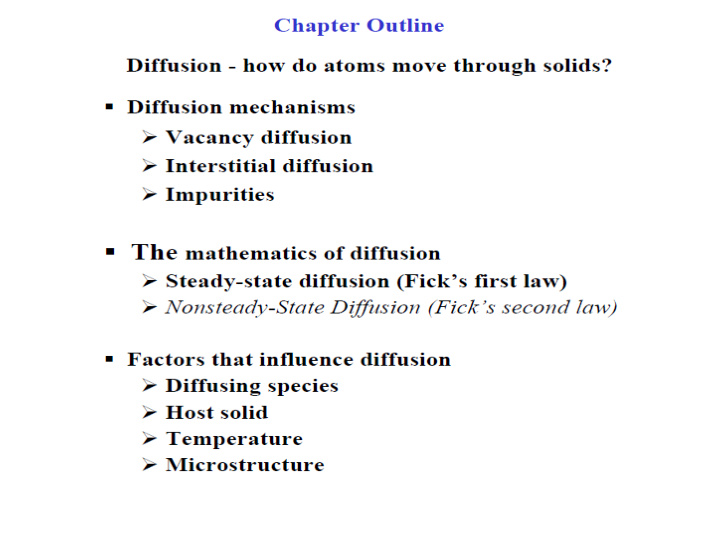



Inhomogeneous materials can become homogeneous by diffusion. For an active diffusion to occur, the temperature should be high enough to overcome energy barriers to atomic motion.
Interdiffusion and Self-diffusion Interdiffusion (or impurity diffusion) occurs in response to a concentration gradient. (Heat) Self-diffusion is diffusion in one-component material, when all atoms that exchange positions are of the same type.
Diffusion Mechanisms (I) Vacancy diffusion To jump from lattice site to lattice site, atoms need energy to break bonds with neighbors, and to cause the necessary lattice distortions during jump. This energy comes from the thermal energy of atomic vibrations (Eav ~ kT) Materials flow (the atom) is opposite the vacancy flow direction.
Diffusion Mechanisms (II) Interstitial diffusion Interstitial diffusion is generally faster than vacancy diffusion because bonding of interstitials to the surrounding atoms is normally weaker and there are many more interstitial sites than vacancy sites to jump to. Requires small impurity atoms (e.g. C, H, O) to fit into interstices in host.
Diffusion Flux The flux of diffusing atoms, J, is used to quantify how fast diffusion occurs. The flux is defined as either in number of atoms diffusing through unit area and per unit time (e.g., atoms/m 2 -second) or in terms of the mass flux - mass of atoms diffusing through unit area per unit time, (e.g., kg/m 2 -second). J = M / At ≅ (1/A) (dM/dt) (Kg m -2 s -1 ) where M is the mass of atoms diffusing through the area A during time t. J A
Steady-State Diffusion Steady state diffusion: the diffusion flux does not change with time. Concentration profile: concentration of atoms/molecules of interest as function of position in the sample. Concentration gradient: dC/dx (Kg.m -3 ): the slope at a particular point on concentration profile.
Steady-State Diffusion: Fick’s first law Fick’s first law: the diffusion flux along direction x is proportional to the concentration gradient J = −D dC /dX where D is the diffusion coefficient The concentration gradient is often called the driving force in diffusion (but it is not a force in the mechanistic sense). The minus sign in the equation means that diffusion is down the concentration gradient.
EXAMPLE PROBLEM 5.1 Diffusion Flux Computation A plate of iron is exposed to a carburizing (carbon-rich) atmosphere on one side and a decarburizing (carbon-deficient) atmosphere on the other side at 700 o C ( 1300F ). If a condition of steady state is achieved, calculate the diffusion flux of carbon through the plate if the concentrations of carbon at positions of 5 and 10 mm and beneath the carburizing surface are 1.2 and 0.8 kg/m3, respectively. Assume a diffusion coefficient of at this temperature.
Nonsteady-State Diffusion: Fick’s second law In most real situations the concentration profile and the concentration gradient are changing with time. The changes of the concentration profile is given in this case by a differential equation, Fick’s second law. Solution of this equation is concentration profile as function of time, C(x,t):
Boundary and initial conditions Solution:
EXAMPLE PROBLEM 5.2 Nonsteady-State Diffusion Time Computation I For some applications, it is necessary to harden the surface of a steel above that of its interior. One way this may be accomplished is by increasing the surface concentration of carbon in a process termed carburizing; the steel piece is exposed, at an elevated temperature, to an atmosphere rich in a hydrocarbon gas, such as methane (CH 4 )Consider one such alloy that initially has a uniform carbon concentration of 0.25 wt% and is to be treated at 950 C (1750 F). If the concentration of carbon at the surface is suddenly brought to and maintained at 1.20 wt%, how long will it take to achieve a carbon content of 0.80 wt% at a position 0.5 mm below the surface? The diffusion coefficient for carbon in iron at this temperature is m 2 /s; assume that the steel piece is semi-infinite.
Example Problem 5.3
Diffusion – Thermally Activated Process In order for atom to jump into a vacancy site, it needs to posses enough energy (thermal energy) to break the bonds and squeeze through its neighbors. The energy necessary for motion, E m , is called the activation energy for vacancy motion. Schematic representation of the diffusion of an atom from its original position into a vacant lattice site. At activation energy E m has to be supplied to the atom so that it could break inter-atomic bonds and to move into the new position.
Diffusion – Thermally Activated Process The average thermal energy of an atom (k B T = 0.026 eV for room temperature) is usually much smaller that the activation energy Em (~ 1 eV /atom) and a large fluctuation in energy (when the energy is “pooled together” in a small volume) is needed for a jump. The probability of such fluctuation or frequency of jumps, R j , depends exponentially from temperature and can be described by equation that is attributed to Swedish chemist where R 0 is an attempt frequency proportional to the frequency of atomic vibrations.
The activation energy Q d and preexponential D 0 , therefore, can be estimated by plotting lnD versus 1/T or logD versus 1/T. Such plots are Arrhenius plots.
Diffusion – Temperature Dependence
Arrhenius plot of diffusivity data for some metallic systems
Diffusion of different species Smaller atoms diffuse more readily than big ones, and diffusion is faster in open lattices or in open directions
Diffusion: Role of the microstructure Self-diffusion coefficients for Ag depend on the diffusion path. In general the diffusivity if greater through less restrictive structural regions – grain boundaries, dislocation cores, external surfaces.
Diffusion: Role of the microstructure
Recommend
More recommend